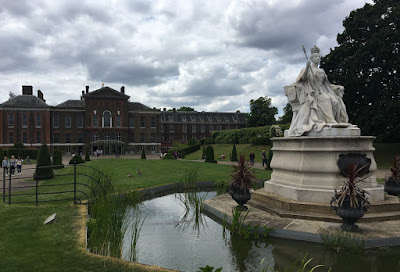Europe 2019, Cont.: England
London, May 30-June 3
Disembarking from the Navigator on May 30, we flew to Gatwick and checked into a bed-sitter near Notting Hill that we had rented on-line. The area is a bit north of Kensington Gardens and offers an array of ethnic restaurants. A major cultural attraction is Saturday’s Portobello Road street market, which features some antiques and a lot of junk, none of which we bought.
 |
| Portobello Road on a Saturday |
Meals provided a way to connect with two British friends. We dined twice at Ottolenghi restaurants, high on our London must-do list; the food was outstanding but the clientele was so young that we must have raised the average age by 10 years. Our last night was a memorable evening at OXO, which featured not only outstanding cuisine but a fantastic view of the Thames. In all these venues neckties were rare.
 |
| Anniversary dinner at Ottolenghi's ROVI |
 |
| The Thames and St. Paul's from OXO |
On the tourist route we chose locations we had not visited before. The Tate Britain featured an exhibition of Van Gogh in London, where we learned that Vincent, who spoke and wrote fluent English, had worked in the city before returning to Holland and taking up art. The Benjamin Franklin house, just off Trafalgar Square, is the only Franklin residence still standing; the staff does a good job of explaining how Ben occupied himself in London from 1757 to 1775.
Kensington Palace, in walking distance from our apartment, includes historic rooms from the eras of William & Mary and George II and a temporary exhibit on Victoria, who was born in the palace and spent her childhood there. Finally, we crossed the Thames to view the new U.S. Embassy, which—unlike President Trump—we found very attractive; as the staff was preparing for the President’s visit, it didn’t seem like a propitious time to tour the interior. No, we didn’t spot the Trump balloon.
 |
| Victoria in front of her girlhood home |
 |
| U.S. Embassy amidst widespread construction on St. George Wharf |
Of course, we took advantage of London’s cultural offerings. The choir boys were on vacation, but we enjoyed evensong at Westminster Abbey sung by an excellent ensemble of lay vicars. Mixing in a bit of Americana, we saw a superb performance of “The Lehman Trilogy” with the three original brothers and all other major figures in the history of Lehman Brothers (including Pete Peterson) played by just three actors—a tour de force.
Wells, June 4-7
We traveled by train from London to Somerset to spend four days with Tony and Judy Lane, our good friends and frequent traveling companions who had moved to a renovated farmhouse near Wells. The centerpiece of Wells, the smallest city in England, is its beautiful 12th century cathedral, which is surrounded by a swan-filled Bishop’s Moat and features unique scissor arches, a 14th century remedy for sinking foundations.
 |
| En route to Wells by foot |
 |
| Cathedral and Bishop's Moat |
 |
| Nave with scissor arches |
 |
| Vicars' Close, reputed to be the only completely medieval street left in England |
In addition to guiding us through the cathedral, the Lanes took us to Stourhead, a 2650-acre Wiltshire estate with a huge 18th century landscape garden festooned with Greek and Roman temples. Its romantic style of landscape architecture, developed in England at that time, struck Tony as an improvement on raw nature.
 |
| Stourhead Garden |










